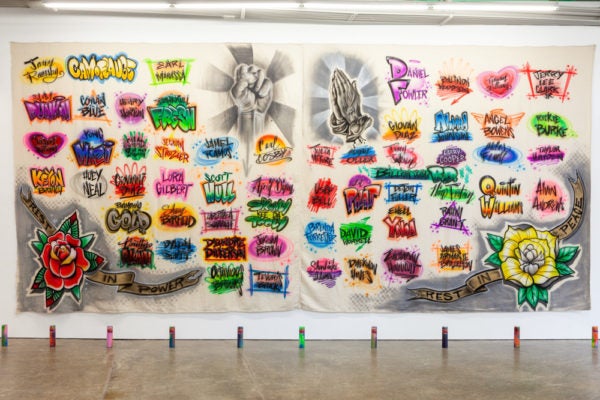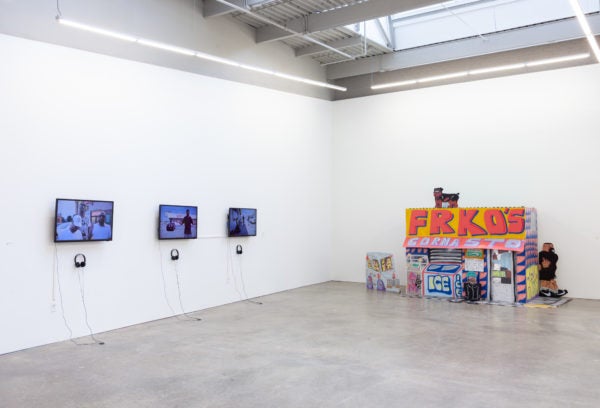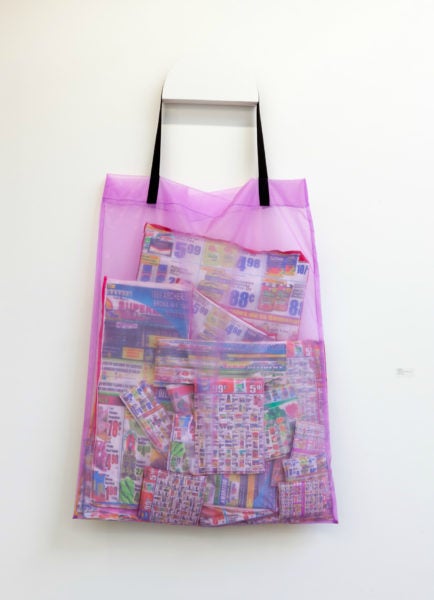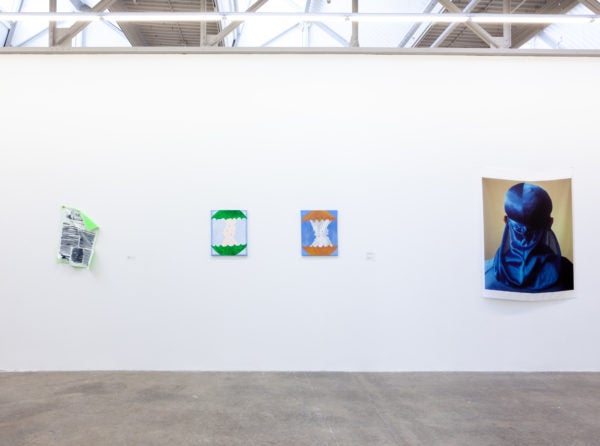
Jokisha Brown. Quintin Williams. Ewell Ynoa.
These names, along with those of other people who were recently murdered, are airbrushed in rows and columns on a large unstretched canvas in Nashville-based artist Brandon Donahue’s installation R.I.P. It’s the first artwork you see as you enter the gallery containing the group show “Vivid Memories of a Blurred Past” at Atlanta Contemporary.
These visual elements—the lively tones of orange, blue, pink, and green; the energetic curves of the text; the playful dollar signs next to the name “Billion Dollar BD”—might all belie the dark subject matter were the imagery not so familiar. Praying hands, a raised fist, and stylized flowers are also airbrushed on the canvas, reminiscent of the T-shirts that commonly memorialize those who have recently died. A line of unlit votive candles forms a barrier on the floor in front of the artwork, a more personally affecting alternative to the usual museum-grade cordons. The scale of the canvas and sheer number of names—there are nearly sixty—confronts the viewer in such a starkly white, pristine space. I realize later that most of the people named would have never imagined themselves as the focus of an artwork by an artist they’d never met, and yet, they are.
R.I.P. is not, however, based in sorrow. It amplifies and centers stories that may otherwise fade into distant memory. It recognizes the reality of these deaths, but it also insists that they should not be forgotten easily. This theme of acknowledging and existing in both spaces—one where the past lingers, the other where time transforms all—is present throughout “Vivid Memories,” which features Donahue’s installation alongside work by artists David Onri Anderson, John Edmonds, Lucia Hierro, FRKO, and Maya Stovall.

In a simple but engaging way, Stovall’s Liquor Store Theatre video series shows transformative forces colliding a familiar context. The videos, which Stovall has been creating since 2014, are set in a Detroit neighborhood and depict Stovall and others dancing in front of some of the area’s numerous liquor stores. Between choreographed dances set to a laid-back soundtrack, Stovall captures interviews with locals about their relationship to the city, politics, art, and gentrification. In the three Liquor Store Theatre episodes presented in this exhibition, the people interviewed are overwhelmingly hopeful about the direction in which Detroit is headed, and they seem to have a deep connection to and love for the city. Every once in a while, you hear Stovall’s disembodied voice ask a question off-camera, adding a degree of cinema verité authenticity to the interaction. In Liquor Store Theatre, vol. 4 no. 7, people step out of the liquor store to watch the dancers, childlike in their curiosity. These liquor stores serve as heartbeats of these communities and become places to which people gravitate. As pillars of the neighborhood, they’ve seen change and adapted to it, and they’ve persisted despite the social and economic struggles of the area. Stovall presents the liquor stores as storied, intimate, and sacred places that serve as living time capsules containing the changing stories, objects, and residents of the neighborhood.

Atlanta-based artist FRKO’S CORNA STO’ installation functions as the focal point of the exhibition. It’s a scaled-down version of a corner store complete with an ice machine, Rottweiler, Newport cigarettes ad, and man drinking MD 20/20 on the sidewalk next to a chalk body outline. FRKO’s whimsical, mischievous art is perhaps a perfect fit for this exhibition, as its colorful nods to Atlanta and hip-hop in the ‘80s and ‘90s are at once nostalgic and original. And CORNA STO’ acts as a complement to Lucia Hierro’s Circulars—an oversized pink polyorganza bag full of market advertisements that hangs on one of the gallery walls—which also subtly addresses issues of consumerism, class, and culture. Part of the Dominican American artist’s Mercado series, Circulars contains images of corn oil, sardines, frozen beef oxtails, and La Poblanita tortillas, among other culturally specific food items. Like the FRKO’s corner store, Hierro’s shopping bag harks back to an institution that played a defining role in her past as well as her development as an artist.
But not all the works refer to physical spaces as records of history and evolution. In Brooklyn-based artist John Edmonds’s photograph Untitled (Du-Rag 3), Edmonds focuses on the du-rag as a motif within Black American culture that dates back centuries. The image, printed on Japanese silk, shows a male figure wearing a blue du-rag against a soft golden background, his back to the camera. The du-rag billowing sumptuously down the figure’s back brings to mind illuminated manuscripts and halos. In Edmonds’s photo, the everyday du-rag is no longer fraught with stigma or bogged down by the weight of its symbolism. Like the site of the liquor stores, its meaning is mutable, ripe for reimagining.

In “Vivid Memories of a Blurred Past,” objects and places contain the DNA of their histories, and shared experiences color our relationship to them. But the past can inform the present without ruling it, as this exhibition suggests. David Onri Anderson’s iterations of jarringly colored, jagged apple cores and the sketches of apple seeds visible beneath the paint in his painting Apple Core Unscrolled reiterate the notion that our understanding of things is continuously evolving.
“The wake—grief, denial, bewilderment, outrage. Her loss, all the more shocking inspired another, less noted reaction. ‘Today, we woke up feeling like strangers in a foreign land,’” reads part of the text that’s not redacted from an enlarged New Yorker article printed on fabric in Hierro’s That Line Tho. As “Vivid Memories” demonstrates, change is perhaps the only constant we can count on. We can look back and move forward at the same time.
“Vivid Memories of a Blurred Past” is on view at Atlanta Contemporary in Atlanta, GA, through December 16.




